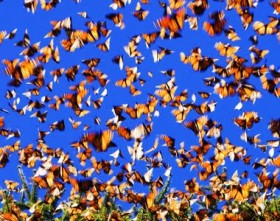 Monarch Weekend at Crossroads will be here before we know it, but will the monarchs be here? and will milkweed shoots be up when they get here? You can mark your calendar that June 8 and 9th is the big event at Crossroads. But butterflies are a bit more unpredictable.
Monarch Weekend at Crossroads will be here before we know it, but will the monarchs be here? and will milkweed shoots be up when they get here? You can mark your calendar that June 8 and 9th is the big event at Crossroads. But butterflies are a bit more unpredictable.
Monarchs migrate, heading south to Mexico for the winter. In the spring, monarchs arrive in Door County, but I hesitate to say return, because the monarchs that left in the fall are not the individuals that should be flitting through our meadows any day now (we hope.) Unlike migrating birds which fly south in the winter and return to their place of birth in spring, our spring monarchs are a different generation than those which flew to Mexico last fall.
We think of butterflies as being adult, sexually mature insects. And in most butterflies, and actually, in the monarchs we see in the summer, that is true. But when the days are getting shorter in the fall, the monarch butterflies remain sexually immature. Rather than participating in mating behavior, they fly approximately 1800 miles to the oyamel forests in a mountainous region of Mexico. There, millions of monarchs cluster, hanging from fir tree branches.
According to the MONARCH WATCH website, “As winter ends and the days grow longer, the Monarchs become more active, beginning to mate and often moving to locations lower on the mountainsides. They leave their Mexican roosts during the second week of March, flying north and east looking for milkweed plants on which to lay their eggs. These Monarchs have already survived a long southward flight in the fall and winter’s cold; they have escaped predatory birds and other hazards along the way, and are the only Monarchs left that can produce a new generation. If they return too early, before the milkweed is up in the spring, they will not be able to lay their eggs and continue the cycle.
“The migrating females lay eggs on the milkweed plants they find as they fly, recolonizing the southern United States before they die. Soon the first spring caterpillars hatch and metamorphose into orange and black adults. It is these newly emerged Monarchs, the offspring of the butterflies that made the fall journey, that recolonize their parents’ original homes.”
According to the JOURNEY NORTH website, it was unseasonably cold in the southern states this spring. Consequently, caterpillar development was slower than usual. But finally, butterflies are heading north, though the population seems to be smaller than in previous years.
We hope will make it to Door County by Monarch weekend. We also hope the milkweed plants will have emerged, so this generation will mate and lay eggs. Last year, many monarchs apparently flew right past Door County an on to Canada and many of the eggs that were laid were attacked by parasites. Last year was not a good year for monarch in the summer and the winter. Actually, last year was not a good year for most plants and animals.Much of what we know about monarch migration comes from more than fifty yeas of research by Dr. Lincoln Brower. Each year, he and his research associate Julie Hein-Frank, study the monarch migration in Newport State Park, and this year, Dr. Brower has graciously offered to present a lecture at Crossroads on June 9 at 7:00 to share his findings.
Chriss Daubner, a Master Gardener and member of Wild Ones, will present a program on Saturday June 8 at 10:00 called: “Inviting Butterflies to Your Garden”. Also on Saturday, a family program and caravan from Crossroads to Newport will be offered. Sunday afternoon, a Cross-generational Class called “Meet the Monarch” will be offered and pre-registration is required for this program. Visit www.crossroadsatbigcreek.org for schedules and program descriptions.
This week, in addition offering the final school field trips for this year, Crossroads will continues to offer programs in science, history and the environment. On Thursday, May 30, at 2:00, our history lecture will be “Penny Candy.” Penny candy is a cherished memory of anyone mature enough to remember when candy really did cost a penny. Learn how Tootsie Rolls got their name, why salt water taffy is not made with salt water, and if the name Black Crows was a typo, what were the candies supposed to be called?. Samples will help stimulate memories and taste buds.
On Tuesday, June 4, at 7:00 the Door Peninsula Astronomical Society invites the community to its June general meeting featuring guest lecturer Kathleen Toerpy, presenting “100-Year Starship Program.” The viewing target of the month will be offered by Gary Henkleman. Refreshments will be served.
Join the naturalist for a one hour ramble in search of wildflowers and other natural
Saturday, June 1, 2:00 Lecture: The History of Penny Candy
Penny candy is a cherished memory of anyone mature enough to remember when candy really did cost a penny. Learn how Tootsie Rolls got their name, why salt water taffy is not made with salt water, and if the name Black Crows was a typo, what were the candies supposed to be called?. Samples will help stimulate memories and taste buds. Free and open to the public. Lecture hall of the Collins Learning Center
#Program: 100-Year Starship Program by Kathleen Toerpy.

